Review of Characterization on Hydrogen Embrittlement by Micro-Sample Testing Methods
Abstract
:1. Background and Introduction
2. Micro-Sample Tensile Test and Hydrogen Embrittlement Characterization
2.1. Application of Small-Size Sample Tensile Test
2.2. Hydrogen Embrittlement Characterization on Micro-Sample Tensile Test
3. Small Punch Test and Hydrogen Embrittlement Sensitivity Analysis
3.1. Description of Small Punch Test
3.2. Hydrogen Embrittlement Sensitivity Analysis by Small Punch Test
4. Nanoindentation Test and Hydrogen-Induced Micro Property Evaluation
4.1. Nanoindentation Theory
4.2. Hydrogen-Induced Micro Property Evaluation Based on Nanoindentation
5. Conclusions and Outlook
Author Contributions
Funding
Conflicts of Interest
References
- Wasim, M.; Djukic, M.B. Hydrogen embrittlement of low carbon structural steel at macro-, micro-and nano-levels. Int. J. Hydrogen Energy 2020, 45, 2145–2156. [Google Scholar] [CrossRef]
- Chen, Y.; Zhao, S.; Ma, H.; Wang, H.; Hua, L.; Fu, S. Analysis of hydrogen embrittlement on aluminum alloys for vehicle-mounted hydrogen storage tanks: A review. Metals 2021, 11, 1303. [Google Scholar] [CrossRef]
- Wu, X.; Zhang, H.; Yang, M.; Jia, W.; Qiu, Y.; Lan, L. From the perspective of new technology of blending hydrogen into natural gas pipelines transmission: Mechanism, experimental study, and suggestions for further work of hydrogen embrittlement in high-strength pipeline steels. Int. J. Hydrogen Energy 2022, 47, 8071–8090. [Google Scholar] [CrossRef]
- Ustolin, F.; Paltrinieri, N.; Berto, F. Loss of integrity of hydrogen technologies: A critical review. Int. J. Hydrogen Energy 2020, 45, 23809–23840. [Google Scholar] [CrossRef]
- Campari, A.; Ustolin, F.; Alvaro, A.; Paltrinieri, N. A review on hydrogen embrittlement and risk-based inspection of hydrogen technologies. Int. J. Hydrogen Energy 2023, in press. [Google Scholar] [CrossRef]
- Zhu, H.; Pan, Q.; Zhang, K.; Zhou, C.; Zhang, W.; Yao, Y.; Zhang, L. The difference in fatigue crack growth induced by internal and external hydrogen in selective laser melted 304L stainless steel. Int. J. Fatigue 2022, 163, 107052. [Google Scholar] [CrossRef]
- Khare, A.; Vishwakarma, M.; Parashar, V. A review on failures of industrial components due to hydrogen embrittlement & techniques for damage prevention. Int. J. Appl. Eng. Res. 2017, 12, 1784–1792. [Google Scholar]
- Li, X.; Ma, X.; Zhang, J.; Akiyama, E.; Wang, Y.; Song, X. Review of hydrogen embrittlement in metals: Hydrogen diffusion, hydrogen characterization, hydrogen embrittlement mechanism and prevention. Acta Metall. Sin. (Engl. Lett.) 2020, 33, 759–773. [Google Scholar] [CrossRef]
- Nagumo, M. Mechanistic Aspects of Fracture I—Brittle Fracture Models. In Fundamentals of Hydrogen Embrittlement; Springer Nature: Singapore, 2023; pp. 245–263. [Google Scholar]
- Wang, S.; Martin, M.L.; Sofronis, P.; Ohnuki, S.; Roberton, I.M. Hydrogen-induced intergranular failure of iron. Acta Mater. 2014, 69, 275–282. [Google Scholar] [CrossRef]
- Katzarov, I.H.; Paxton, A.T. Hydrogen embrittlement II. Analysis of hydrogen-enhanced decohesion across (111) planes in α-Fe. Phys. Rev. Mater. 2017, 1, 033603. [Google Scholar] [CrossRef]
- Birnbaum, H.K.; Sofronis, P. Hydrogen-enhanced localized plasticity—A mechanism for hydrogen-related fracture. Mater. Sci. Eng. A 1994, 176, 191–202. [Google Scholar] [CrossRef]
- Martin, M.L.; Dadfarnia, M.; Nagao, A.; Wang, S.; Sofronis, P. Enumeration of the hydrogen-enhanced localized plasticity mechanism for hydrogen embrittlement in structural materials. Acta Mater. 2019, 165, 734–750. [Google Scholar] [CrossRef]
- Wasim, M.; Djukic, M.B.; Ngo, T.D. Influence of hydrogen-enhanced plasticity and decohesion mechanisms of hydrogen embrittlement on the fracture resistance of steel. Eng. Fail. Anal. 2021, 123, 105312. [Google Scholar] [CrossRef]
- Lin, M.; Yu, H.; Ding, Y.; Wang, G.; Olden, V.; Alvaro, A.; He, J.; Zhang, Z. A predictive model unifying hydrogen enhanced plasticity and decohesion. Scr. Mater. 2022, 215, 114707. [Google Scholar] [CrossRef]
- Nguyen, T.T.; Tak, N.; Park, J.; Nahm, S.H.; Beak, U.B. Hydrogen embrittlement susceptibility of X70 pipeline steel weld under a low partial hydrogen environment. Int. J. Hydrogen Energy 2020, 45, 23739–23753. [Google Scholar] [CrossRef]
- Wang, C.; Zhang, J.; Liu, C.; Hu, Q.; Zhang, R.; Xu, X.; Yang, H.; Ning, Y.; Li, Y. Study on hydrogen embrittlement susceptibility of X80 steel through in-situ gaseous hydrogen permeation and slow strain rate tensile tests. Int. J. Hydrogen Energy 2023, 48, 243–256. [Google Scholar] [CrossRef]
- Singh, D.K.; Raman RK, S.; Maiti, S.K.; Bhandakkar, T.K.; Pal, S. Investigation of role of alloy microstructure in hydrogen-assisted fracture of AISI 4340 steel using circumferentially notched cylindrical specimens. Mater. Sci. Eng. A 2017, 698, 191–197. [Google Scholar] [CrossRef]
- Cayón, A.; Gutiérrez-Solana, F.; Arroyo, B.; Lvarez, J.A. Hydrogen embrittlement processes in microalloyed steel notched tensile samples. Theor. Appl. Fract. Mech. 2021, 112, 102878. [Google Scholar] [CrossRef]
- Arniella, V.; Zafra, A.; Álvarez, G.; Rodriguez, C. Comparative study of embrittlement of quenched and tempered steels in hydrogen environments. Int. J. Hydrogen Energy 2022, 47, 17056–17068. [Google Scholar] [CrossRef]
- Arniella, V.; Álvarez, G.; Belzunce, J.; Rodriguez, C. Hydrogen embrittlement of 2205 duplex stainless steel in in-situ tensile tests. Theor. Appl. Fract. Mech. 2023, 124, 103794. [Google Scholar] [CrossRef]
- Nguyen, T.T.; Park, J.S.; Kim, W.S.; Nahm, S.H.; Beak, U.B. Environment hydrogen embrittlement of pipeline steel X70 under various gas mixture conditions with in situ small punch tests. Mater. Sci. Eng. A 2020, 781, 139114. [Google Scholar] [CrossRef]
- Nguyen, T.T.; Park, J.S.; Nahm, S.H.; Beak, U.B. Evaluation of hydrogen related degradation of API X42 pipeline under hydrogen/natural gas mixture conditions using small punch test. Theor. Appl. Fract. Mech. 2021, 113, 102961. [Google Scholar] [CrossRef]
- Lulu-Bitton, N.; Navi, N.U.; Rosen, B.A.; Haroush, S.; Sabatani, E.; Eretz-Kdosha, Y.; Agronov, G.; Eliaz, N. The influence of gaseous hydrogen charging on the microstructural and mechanical behavior of electron beam melted and wrought Ti–6Al–4V alloys using the small punch test. Int. J. Hydrogen Energy 2023, 48, 34077–34093. [Google Scholar] [CrossRef]
- Wang, X.; Zhu, T.; Zhang, J.; Ding, H.; Xiao, S.; Lu, L.; Yang, B.; Yang, G.; Liu, Y. A review of selected small specimen test techniques for identifying deformation and failure properties of metallic materials. J. Mater. Sci. 2023, 58, 63–100. [Google Scholar] [CrossRef]
- Zheng, P.; Chen, R.; Liu, H.; Chen, J.; Zhang, Z.; Liu, X.; Shen, Y. On the standards and practices for miniaturized tensile test—A review. Fusion Eng. Des. 2020, 161, 112006. [Google Scholar] [CrossRef]
- Song, M.; Guan, K.; Qin, W.; Szpunar, J.A.; Chen, J. Size effect criteria on the small punch test for AISI 316L austenitic stainless steel. Mater. Sci. Eng. A 2014, 606, 346–353. [Google Scholar] [CrossRef]
- Roach, A.M.; White, B.C.; Garland, A.; Jared, B.H.; Carroll., J.D.; Boyce, B.L. Size-dependent stochastic tensile properties in additively manufactured 316L stainless steel. Addit. Manuf. 2020, 32, 101090. [Google Scholar] [CrossRef]
- Gussev, M.N.; Howard, R.H.; Terrani, K.A.; Field, K.G. Sub-size tensile specimen design for in-reactor irradiation and post-irradiation testing. Nucl. Eng. Des. 2017, 320, 298–308. [Google Scholar] [CrossRef]
- Liu, H.; Chen, R.; Wen, M.; Zhang, L.; Shen, Y. Optimizing parallel section length for small tensile specimen with fabrication non-uniformity in thickness. Fusion Eng. Des. 2019, 147, 111244. [Google Scholar] [CrossRef]
- Liu, H.; Shen, Y.; Yang, S.; Zhang, P.; Zhang, L. A comprehensive solution to miniaturized tensile testing: Specimen geometry optimization and extraction of constitutive behaviors using inverse FEM procedure. Fusion Eng. Des. 2017, 121, 188–197. [Google Scholar] [CrossRef]
- Wan, D.; Deng, Y.; Barnoush, A. Hydrogen embrittlement effect observed by in-situ hydrogen plasma charging on a ferritic alloy. Scr. Mater. 2018, 151, 24–27. [Google Scholar] [CrossRef]
- Depover, T.; Wan, D.; Wang, D.; Barnoush, A.; Verbeken, K. The effect of hydrogen on the crack initiation site of TRIP-assisted steels during in-situ hydrogen plasma micro-tensile testing: Leading to an improved ductility? Mater. Charact. 2020, 167, 110493. [Google Scholar] [CrossRef]
- Mine, Y.; Koga, K.; Kraft, O.; Takashima, K. Mechanical characterisation of hydrogen-induced quasi-cleavage in a metastable austenitic steel using micro-tensile testing. Scr. Mater. 2016, 113, 176–179. [Google Scholar] [CrossRef]
- Asadipoor, M.; Anaraki, A.P.; Kadkhodapour, J.; Sharifi, S.M.H.; Barnoush, A. Macro-and microscale investigations of hydrogen embrittlement in X70 pipeline steel by in-situ and ex-situ hydrogen charging tensile tests and in-situ electrochemical micro-cantilever bending test. Mater. Sci. Eng. A 2020, 772, 138762. [Google Scholar] [CrossRef]
- Ueki, S.; Oura, R.; Mine, Y.; Takashima, K. Micro-mechanical characterisation of hydrogen embrittlement in nano-twinned metastable austenitic stainless steel. Int. J. Hydrogen Energy 2020, 45, 27950–27957. [Google Scholar] [CrossRef]
- GB/T 29459-2012; Test Method for Small Punch Testing of Metallic Materials for In-Service Pressurized Equipment. China National Standardization Management Committee: Beijing, China, 2012.
- ASTM E3205-2020; Standard Test Method for Small Punch Testing of Metallic Materials. ASTM International: Conshohocken, PA, USA, 2020.
- BS EN 10371-2021; Metallic Materials—Small Punch Test Method. British Standards Institution: London, UK, 2021.
- Li, K.; Peng, J.; Zhou, C. Construction of whole stress-strain curve by small punch test and inverse finite element. Results Phys. 2018, 11, 440–448. [Google Scholar] [CrossRef]
- Geng, X.; Peng, J.; Jiang, L.; Liu, X.; Tu, Y.; Xue, Z. Experimental study of mechanical properties and fracture modes in different regions of the nickel-based welding joint based on small punch test. Weld. World 2023, 67, 637–650. [Google Scholar] [CrossRef]
- Altstadt, E.; Bergner, F.; Houska, M. Use of the small punch test for the estimation of ductile-to-brittle transition temperature shift of irradiated steels. Nucl. Mater. Energy 2021, 26, 100918. [Google Scholar] [CrossRef]
- Lai, H.S.; Jiang, X. Determination of fracture toughness through small punch test of notched-tube specimen. Eng. Fract. Mech. 2023, 279, 109059. [Google Scholar] [CrossRef]
- Sun, W.; Li, M.; Wen, Z.; Zhou, G.; Yue, Z.; Tu, S. Uncertainties in and Recommendations to Small Punch Tensile and Creep Tests for Ductile Materials. Eng. Fract. Mech. 2023, 289, 109443. [Google Scholar] [CrossRef]
- Lancaster, R.J.; Jeffs, S.P.; Haigh, B.J.; Barnard, N.C. Derivation of material properties using small punch and shear punch test methods. Mater. Des. 2022, 215, 110473. [Google Scholar] [CrossRef]
- Leclerc, N.; Khosravani, A.; Hashemi, S.; Miracle, D.B.; Kalidindi, S.R. Correlation of measured load-displacement curves in small punch tests with tensile stress-strain curves. Acta Mater. 2021, 204, 116501. [Google Scholar] [CrossRef]
- Peng, J.; Vijayanand, V.D.; Knowles, D.; Truman, C.; Mostafavi, M. The sensitivity ranking of ductile material mechanical properties, geometrical factors, friction coefficients and damage parameters for small punch test. Int. J. Press. Vessel. Pip. 2021, 193, 104468. [Google Scholar] [CrossRef]
- CWA 15627-2007; Small Punch Test Method for Metallic Material. European Committee for Standardization: Brussels, Belgium, 2007.
- Shin, H.S.; Yeo, J.; Baek, U.B. Influence of specimen surface roughness on hydrogen embrittlement induced in austenitic steels during in-situ small punch testing in high-pressure hydrogen environments. Metals 2021, 11, 1579. [Google Scholar] [CrossRef]
- Bae, K.O.; Shin, H.S.; Baek, U.B. Quantitative evaluation of hydrogen embrittlement susceptibility in various steels for energy use using an in-situ small punch test. Int. J. Hydrogen Energy 2021, 46, 20107–20118. [Google Scholar] [CrossRef]
- Shin, H.S.; Custodio, N.A.; Baek, U.B. Numerical analysis for characterizing hydrogen embrittlement behaviors induced in STS316L stainless steel using an in-situ small-punch test. Theor. Appl. Fract. Mech. 2021, 116, 103139. [Google Scholar] [CrossRef]
- Shin, H.S.; Bae, K.O.; Baek, U.B.; Nahm, S.H. Establishment of an in-situ small punch test method for characterizing hydrogen embrit-tlement behaviors under hydrogen gas environments and new influencing factor. Int. J. Hydrogen Energy 2019, 44, 23472–23483. [Google Scholar] [CrossRef]
- Álvarez, G.; Arniella, V.; Belzunce, F.J.; Rodriguez, C. Study of the influence of current density and displacement rate on hydrogen em-brittlement using small punch tests. Theor. Appl. Fract. Mech. 2023, 125, 103838. [Google Scholar] [CrossRef]
- Oliver, W.C.; Pharr, G.M. An improved technique for determining hardness and elastic modulus using load and displacement sensing indentation experiments. J. Mater. Res. 1992, 7, 1564–1583. [Google Scholar] [CrossRef]
- Oliver, W.C.; Pharr, G.M. Measurement of hardness and elastic modulus by instrumented indentation: Advances in under-standing and refinements to methodology. J. Mater. Res. 2004, 19, 3–20. [Google Scholar] [CrossRef]
- Hong, Y.; Zhou, C.; Zheng, Y.; Zhang, L.; An, B.; Chen, X.; Wang, X. Hydrogen effect on the deformation evolution process in situ detected by nanoindentation continuous stiffness measurement. Mater. Charact. 2017, 127, 35–40. [Google Scholar] [CrossRef]
- Hong, Y.; Zhou, C.; Zheng, Y.; Zhang, L.; Zheng, J.; Chen, X. Effect of hydrogen and strain rate on nanoindentation creep of austenitic stainless steel. Int. J. Hydrogen Energy 2019, 44, 1253–1262. [Google Scholar] [CrossRef]
- Hong, Y.; Zhou, C.; Zheng, Y.; Zhang, L.; Zheng, J.; Chen, X. Dependence of strain rate on hydrogen-induced hardening of austenitic stainless steel investigated by nanoindentation. Int. J. Hydrogen Energy 2019, 44, 14055–14063. [Google Scholar] [CrossRef]
- Barnoush, A.; Zamanzade, M.; Vehoff, H. Direct observation of hydrogen enhanced plasticity in super duplex stainless steel by means of in situ electrochemical methods. Scr. Mater. 2010, 62, 242–245. [Google Scholar] [CrossRef]
- Barnoush, A.; Vehoff, H. Recent developments in the study of hydrogen embrittlement: Hydrogen effect on dislocation nucleation. Acta Mater. 2010, 58, 5274–5285. [Google Scholar] [CrossRef]
- Barnoush, A.; Asgari, M.; Johnsen, R. Resolving the hydrogen effect on dislocation nucleation and mobility by electrochemical nanoindentation. Scr. Mater. 2012, 66, 414–417. [Google Scholar] [CrossRef]
- Kheradmand, N.; Johnsen, R.; Olsen, J.S.; Barnoush, A. Effect of hydrogen on the hardness of different phases in super duplex stainless steel. Int. J. Hydrogen Energy 2016, 41, 704–712. [Google Scholar] [CrossRef]
- Basa, A.; Wang, D.; Espallargas, N.; Wan, D. An in-situ electrochemical nanoindentation (ECNI) study on the effect of hydrogen on the mechanical properties of 316L austenitic stainless steel. Materials 2021, 14, 6426. [Google Scholar] [CrossRef]
- Hong, Y.; Zhou, C.; Zheng, Y.; Zhang, L.; Chen, X. Hydrogen effect on nanoindentation creep of austenitic stainless steel: A comparative study between primary creep stage and steady-state creep stage. Int. J. Hydrogen Energy 2019, 44, 22576–22583. [Google Scholar] [CrossRef]
- Lucas, B.N.; Oliver, W.C. Indentation power-law creep of high-purity indium. Metall. Mater. Trans. A 1999, 30, 601–610. [Google Scholar] [CrossRef]
- Durst, K.; Maier, V. Dynamic nanoindentation testing for studying thermally activated processes from single to nanocrystalline metals. Curr. Opin. Solid State Mater. Sci. 2015, 19, 340–353. [Google Scholar] [CrossRef]
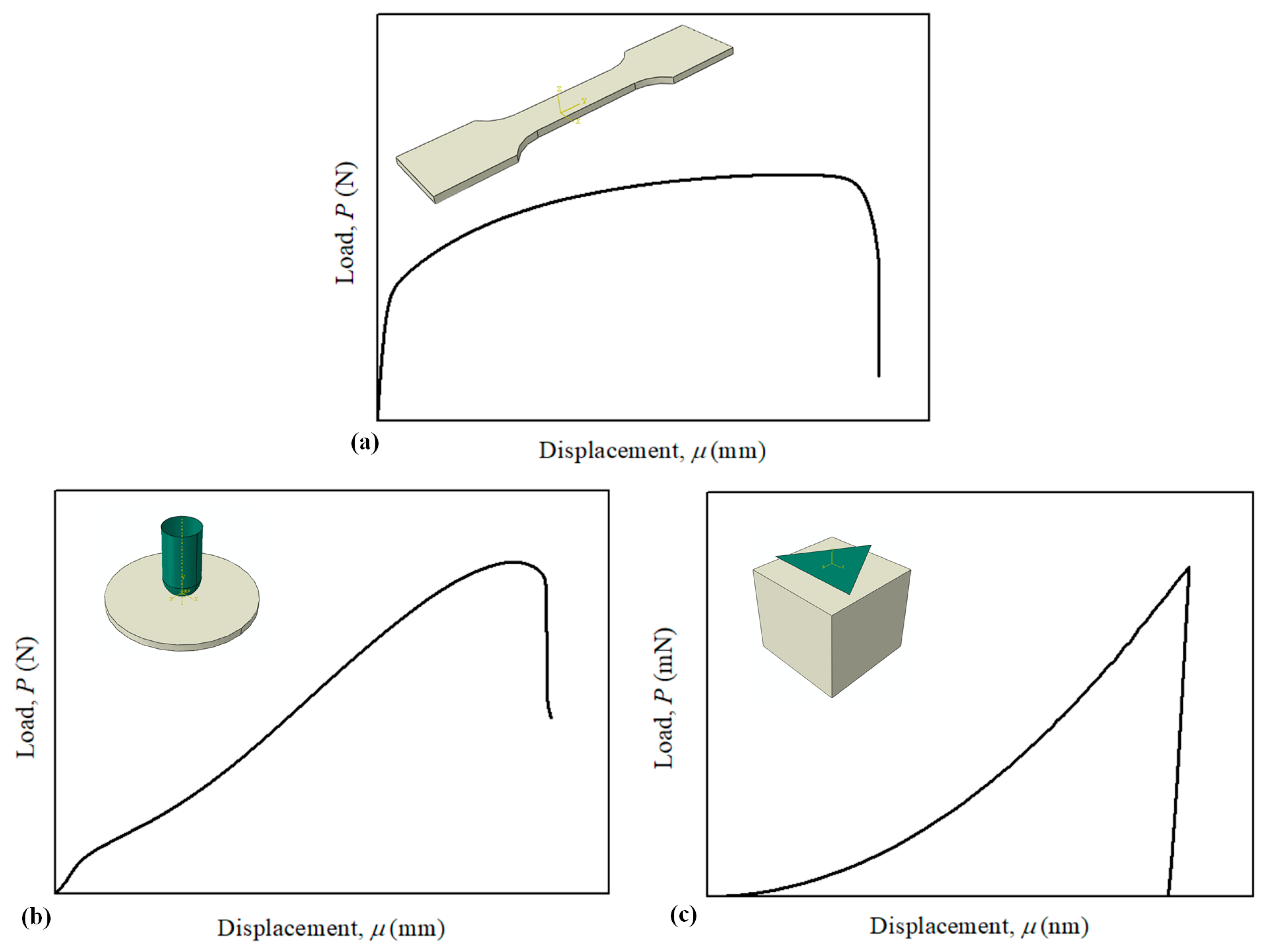
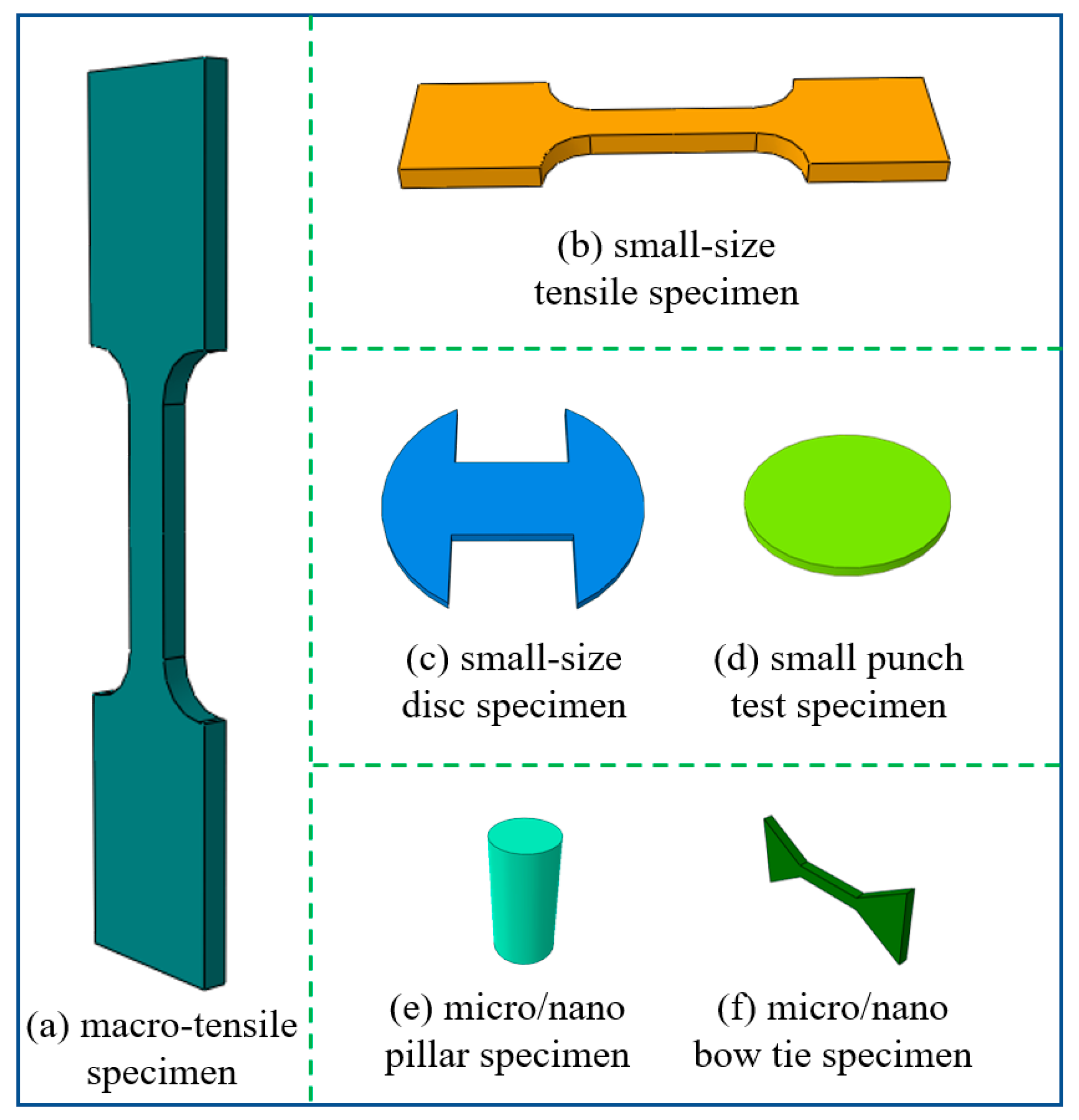
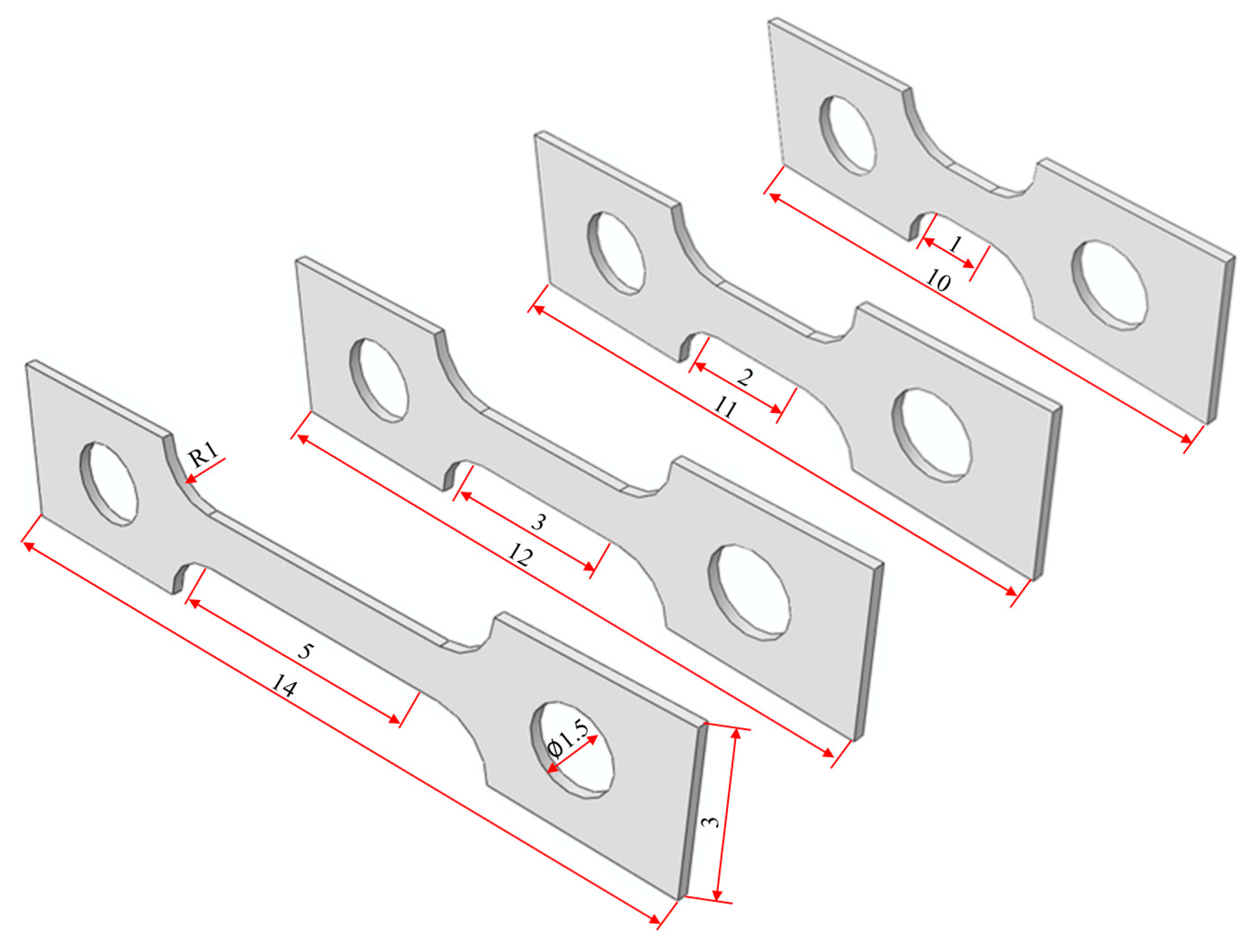

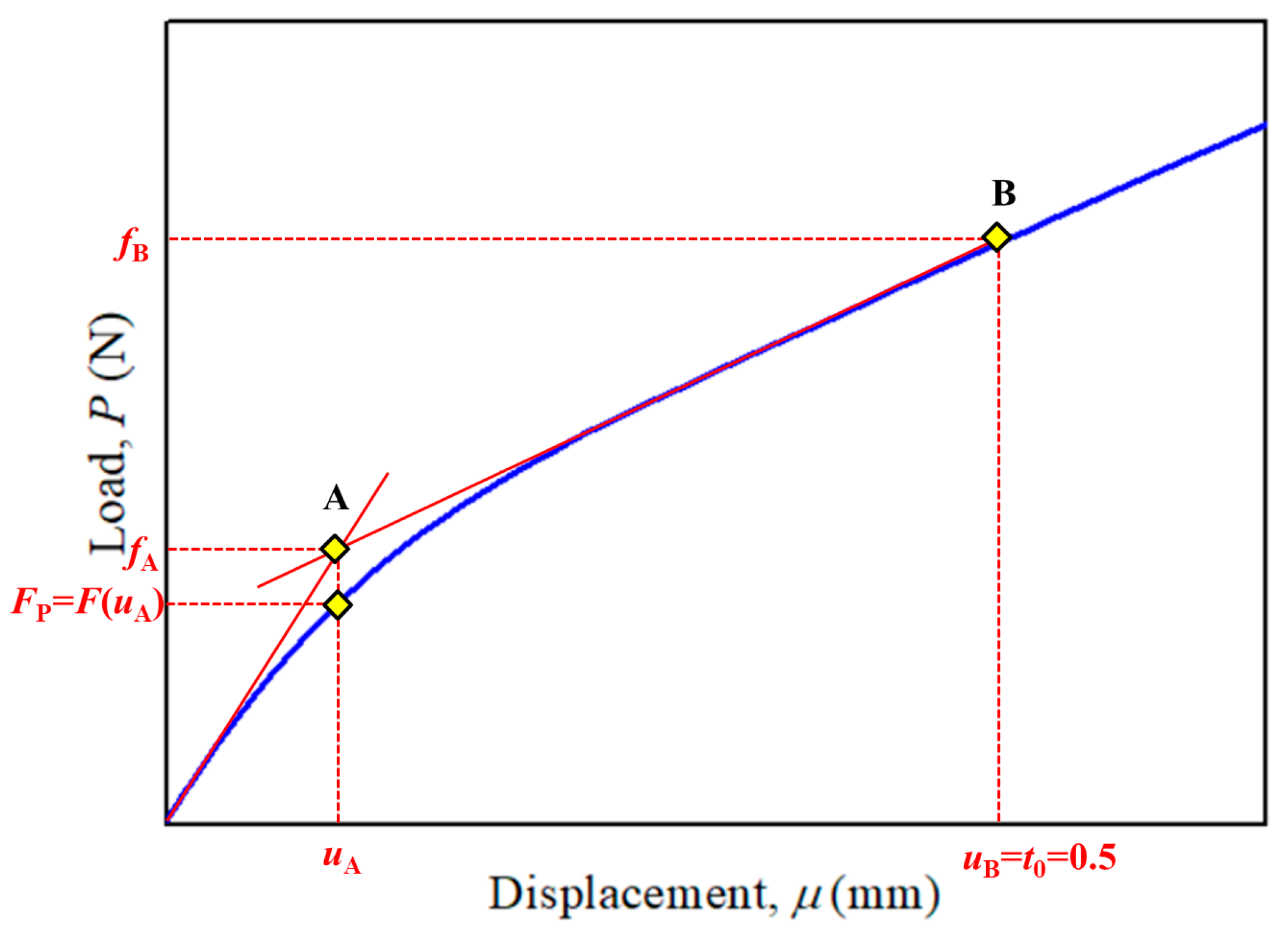

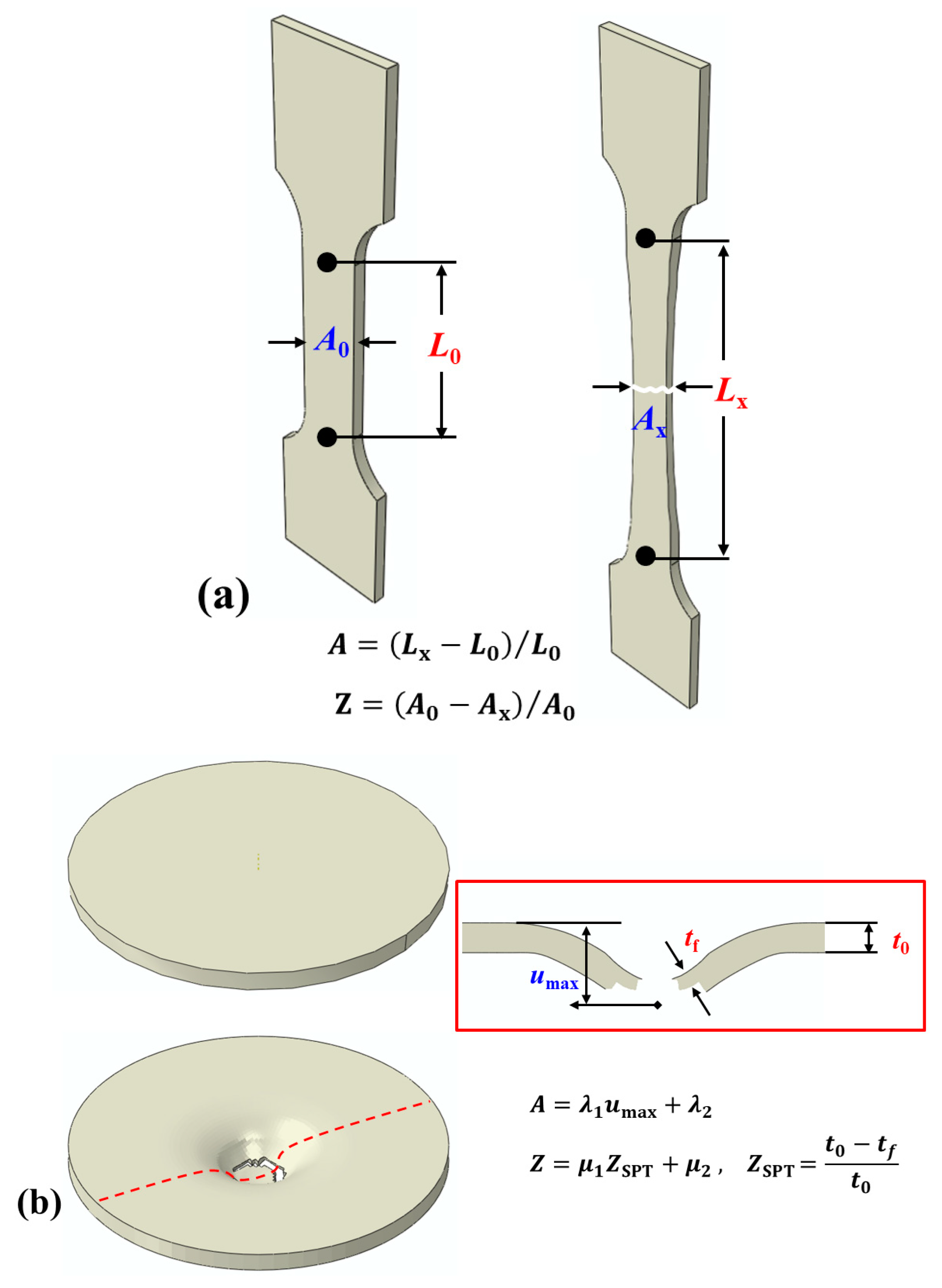
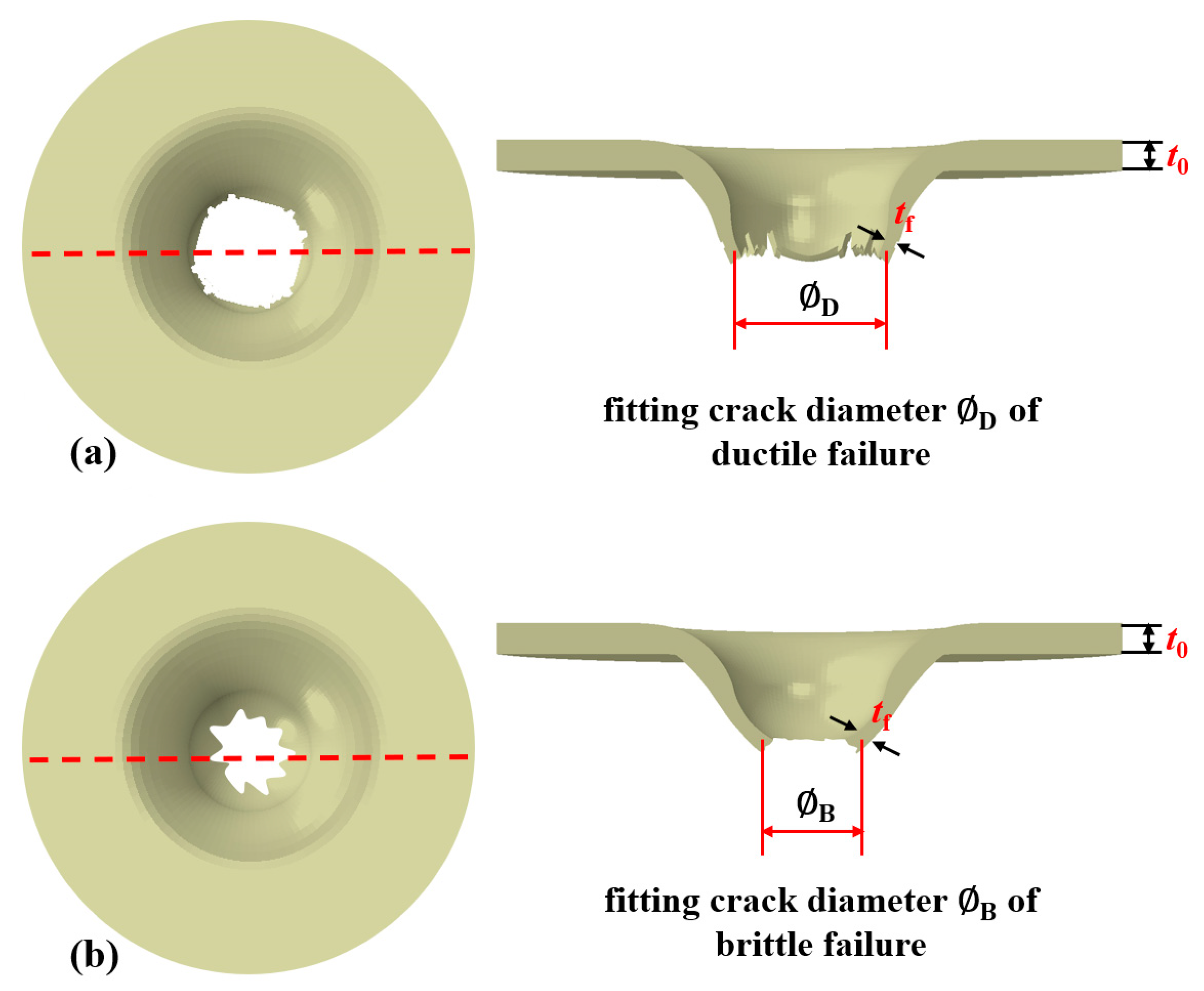

| Material | Punch Velocity v (mm/min) | Maximum Load Fmax (N) | Fracture Displacement uf (mm) | ROT (%) | RRT (%) | Environment |
|---|---|---|---|---|---|---|
| SA372 [50,52] | 1.0 | 2487 | 2.01 | 50.57 | / | N2 (10 MPa) |
| 1.0 | 1487 | 1.08 | 23.92 | 47.37 | H2 (10 MPa) | |
| 0.1 | 1277 | 1.01 | 22.05 | 44.82 | ||
| 0.01 | 976 | 0.96 | 15.43 | 30.81 | ||
| STS304 [50,52] | 1.0 | 3128 | 2.68 | 55.52 | / | N2 (10 Mpa) |
| 1.0 | 1207 | 1.38 | 22.41 | 40.17 | H2 (10 MPa) | |
| 0.1 | 953 | 1.13 | 19.86 | 35.59 | ||
| 0.01 | 905 | 1.12 | 18.85 | 34.07 | ||
| STS316L [51] | 1.0 | 2796 | 2.48 | / | / | N2 (10 MPa) |
| 1.0 | 2121 | 1.81 | / | 99~100 | H2 (10 MPa) | |
| 0.1 | 1960 | 1.80 | / | 99~100 | ||
| 0.01 | 1659 | 1.67 | / | 99~100 | ||
| 24.5 wt% Mn [50] | 1.0 | 3572 | 2.284 | 44.91 | / | N2 (10 MPa) |
| 1.0 | 1288 | 1.16 | 21.05 | 47.17 | H2 (10 MPa) | |
| 0.1 | 1038 | 0.87 | 16.16 | 35.77 | ||
| 0.01 | 794 | 0.80 | 16.14 | 35.75 | ||
| 9% Ni [50] | 1.0 | 2688 | 2.30 | 60.42 | / | N2 (10 MPa) |
| 1.0 | 1720 | 1.23 | 28.11 | 47.26 | H2 (10 MPa) | |
| 0.1 | 1643 | 1.18 | 28.09 | 47.23 | ||
| 0.01 | 1379 | 1.10 | 24.02 | 40.89 |
| Punch Velocity v (mm/min) | Maximum Load Fmax (N) | Maximum Displacement umax (mm) | Fracture Thickness tf (mm) | HE Index | Environment | ||
|---|---|---|---|---|---|---|---|
| 0.2 | 1764 | 1.54 | 0.158 | / | / | / | Uncharged |
| 0.26 | 1600 | 1.30 | 0.224 | 19.85 | 30.01 | 14.29 | Electrochemically charged 0.5 mA/cm2 |
| 0.2 | 1630 | 1.37 | 0.254 | 27.14 | 42.88 | 15.71 | |
| 0.14 | 1418 | 1.12 | 0.316 | 47.34 | 60.07 | 17.99 | |
| 0.08 | 1211 | 1.00 | 0.392 | 57.90 | 85.17 | 24.53 | |
| 0.02 | 1015 | 0.91 | 0.479 | 64.58 | 94.44 | 35.98 | |
| 0.002 | 709 | 0.61 | 0.356 | 79.63 | 90.04 | 41.32 | |
| 0.001 | 582 | 0.57 | 0.406 | 85.21 | 93.52 | 45.50 | |
| 0.26 | 1616 | 1.35 | 0.258 | 25.07 | 42.88 | 16.32 | Electrochemically charged 1 mA/cm2 |
| 0.2 | 1346 | 1.11 | 0.346 | 51.00 | 68.25 | 17.99 | |
| 0.14 | 1362 | 1.12 | 0.376 | 52.58 | 78.15 | 21.16 | |
| 0.08 | 1078 | 0.91 | 0.393 | 66.30 | 79.32 | 26.68 | |
| 0.02 | 826 | 0.80 | 0.423 | 71.15 | 95.37 | 38.10 | |
| 0.002 | 639 | 0.62 | 0.408 | 81.71 | 95.44 | 43.92 | |
| 0.001 | 683 | 0.57 | 0.396 | 84.75 | 92.60 | 44.29 | |
Disclaimer/Publisher’s Note: The statements, opinions and data contained in all publications are solely those of the individual author(s) and contributor(s) and not of MDPI and/or the editor(s). MDPI and/or the editor(s) disclaim responsibility for any injury to people or property resulting from any ideas, methods, instructions or products referred to in the content. |
© 2023 by the authors. Licensee MDPI, Basel, Switzerland. This article is an open access article distributed under the terms and conditions of the Creative Commons Attribution (CC BY) license (https://creativecommons.org/licenses/by/4.0/).
Share and Cite
Tao, P.; Zhou, W.; Miao, X.; Peng, J.; Liu, W. Review of Characterization on Hydrogen Embrittlement by Micro-Sample Testing Methods. Metals 2023, 13, 1753. https://doi.org/10.3390/met13101753
Tao P, Zhou W, Miao X, Peng J, Liu W. Review of Characterization on Hydrogen Embrittlement by Micro-Sample Testing Methods. Metals. 2023; 13(10):1753. https://doi.org/10.3390/met13101753
Chicago/Turabian StyleTao, Ping, Wei Zhou, Xinting Miao, Jian Peng, and Wenming Liu. 2023. "Review of Characterization on Hydrogen Embrittlement by Micro-Sample Testing Methods" Metals 13, no. 10: 1753. https://doi.org/10.3390/met13101753
APA StyleTao, P., Zhou, W., Miao, X., Peng, J., & Liu, W. (2023). Review of Characterization on Hydrogen Embrittlement by Micro-Sample Testing Methods. Metals, 13(10), 1753. https://doi.org/10.3390/met13101753







